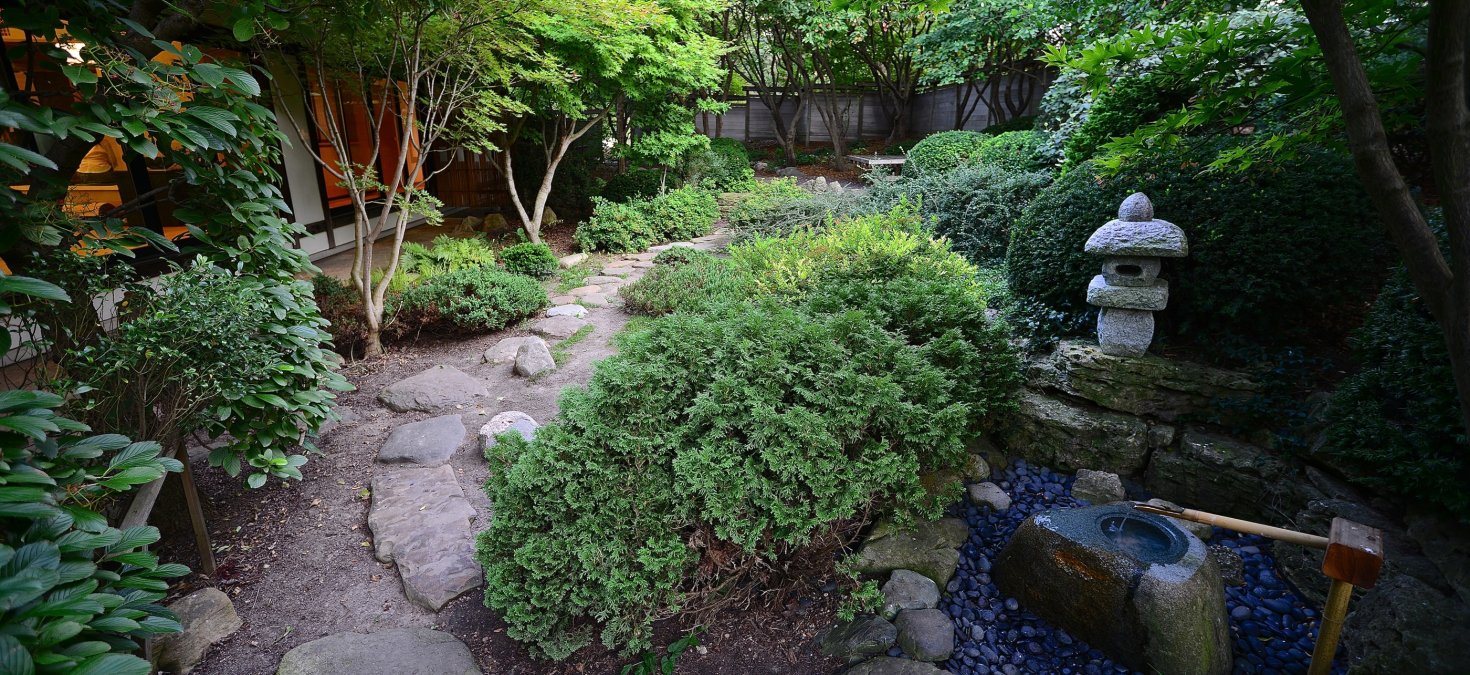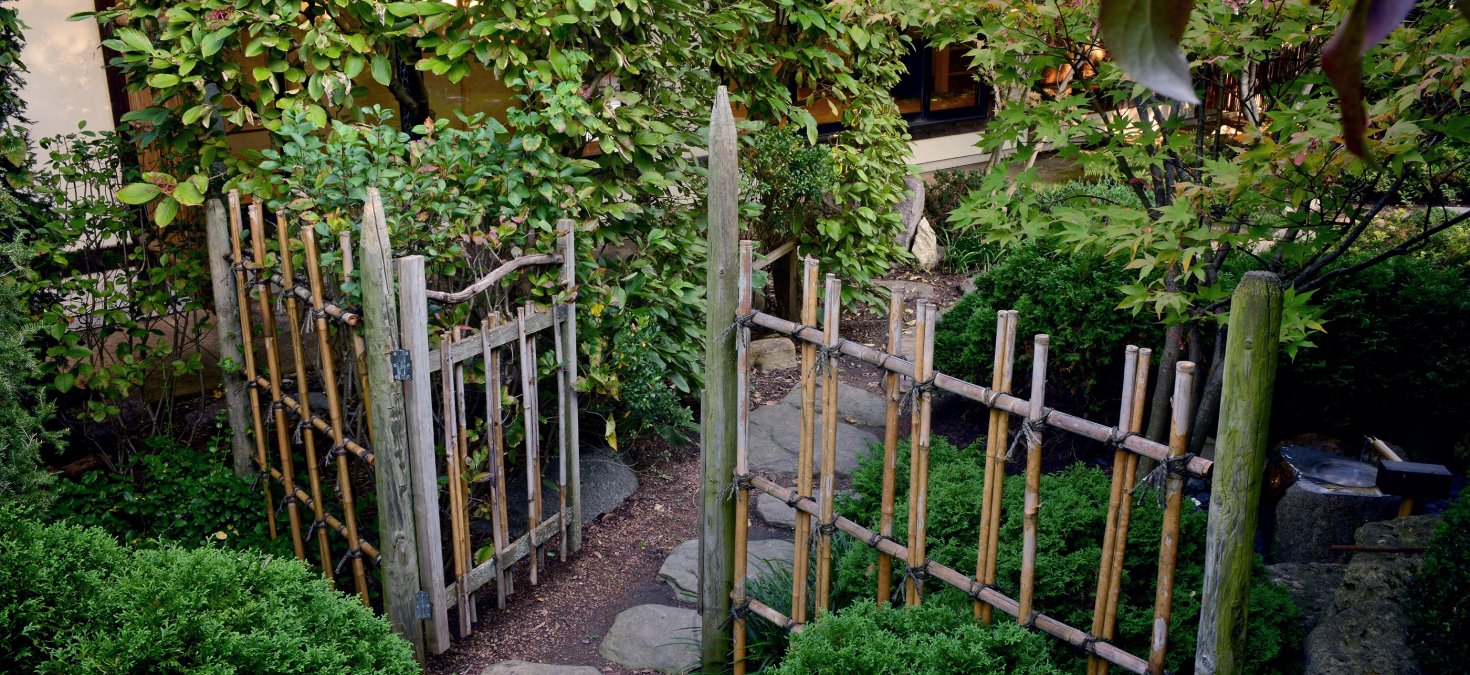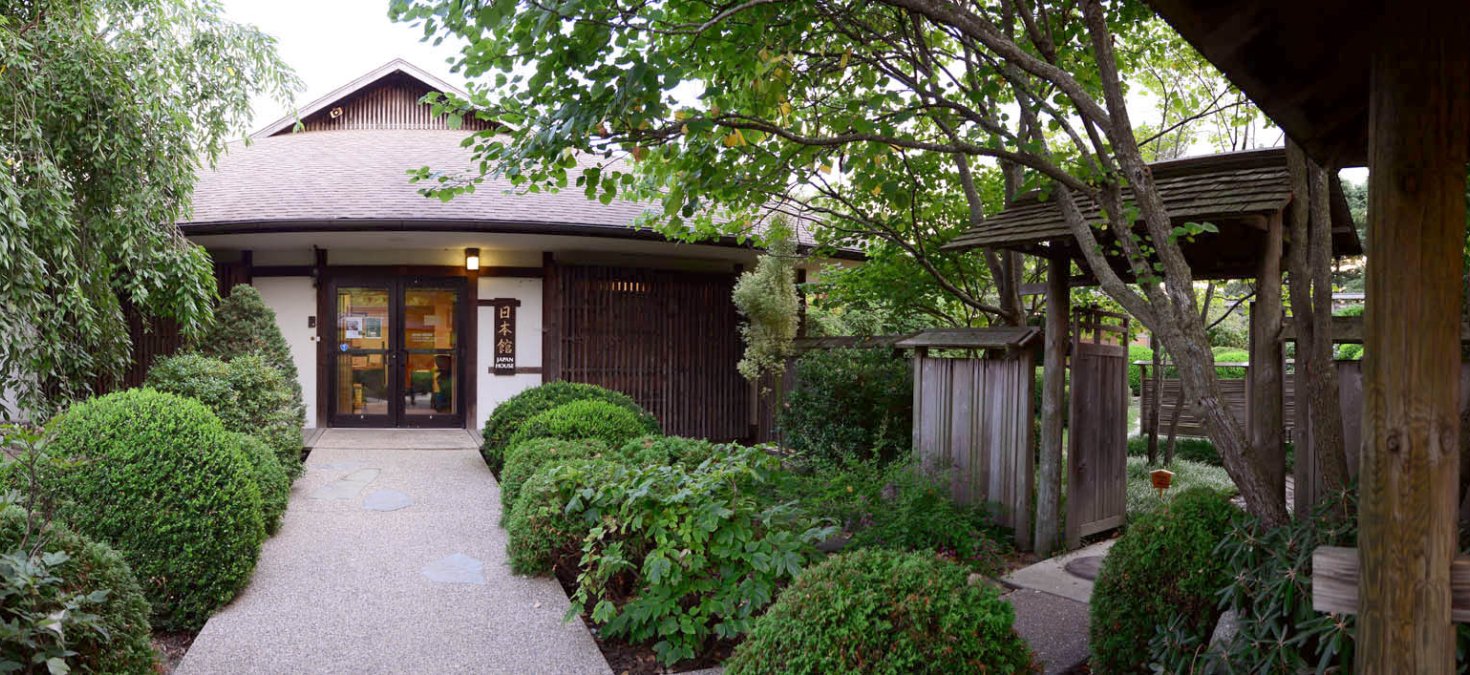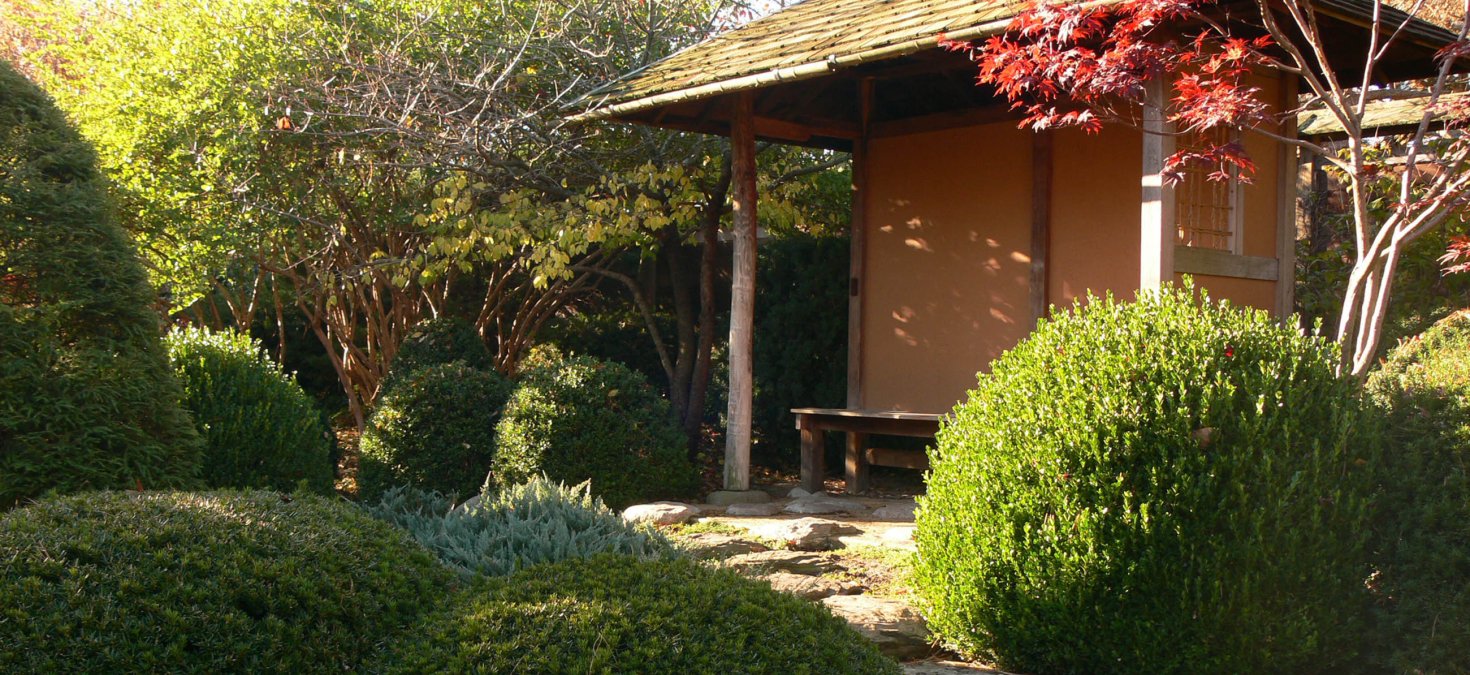The Tea Garden (Cha Niwa)

The present-day Japanese Tea Garden has a history dating back to the sixteenth century and the great developer and teacher of the tea ceremony, Sen-no-Rikyu (1522-91). Before then, Japanese gardens were not so much for walking but more for viewing from nearby buildings or from boats on the garden ponds (Heian period 794-1185, and later). The Tea Garden established a number of elements such as lanterns, stepping stones, bamboo fences, and water basins which were an enormous influence on Japanese landscaping to follow, especially in the expansive Stroll Garden (Kayushiki) style built by the regional rulers (Daimyo) for their pleasure and as evidence of their importance.
Tea gardens and the art of serving tea (Chanoyu) have been based on the philosophy of Zen Buddhism. As a result, most of the early gardens were associated with temples. Through time, the tea ceremony took place in a special room or in a separate tea pavilion located on the grounds of the aristocrats, but not anywhere for the common man. Today, tea rooms and gardens can be found in corporations, hotels, schools, and even department stores in Japan. Still, it is not part of the everyday worker’s household.

In summer and winter, small quiet accents or discoveries are found “here and there.” The garden is always built in two parts, Outer Garden (Soto-Roji) and Inner Garden (Uchi-Roji), with one in contrast to the other. The word Roji, another name for Tea Garden, can have the meaning of “the dewy path to spiritual enlightenment” and is reflected in the stepping-stone path through the garden. Ideally, the transition from the Outer Garden into the Inner Garden should give the sense of leaving a structured environment and entering a remote, natural setting of hills or valleys, a rustic scene. The transition in the Japan House Tea Garden is at the bamboo gate and tall hemlock hedge near it.
The Outer Garden is somewhat formal, predominantly evergreen and more open with some tightly clipped shrubs. An Inner Garden is more natural with a tree canopy and naturally-shaped or lightly trimmed shrubs. Also, there are more deciduous plants and shade, so much at times as to create a moss-covered floor. Since moss is difficult to maintain in our soil and climate, the Inner Garden here is fringed with trees but left open in the center so that sun-loving, moss-looking plants can grow.
Tea gardens are built small and without show, subdued in color and fragrance except for sequential spring and autumn display.
A typical tea house (Chashitsu) located in a tea garden or, more commonly as rooms a part of a main house structure, consists of an room approximately nine feet square (four and one-half tatami mats with dimensions of three by six feet) for guests and a preparation room for the host or hostess. At Japan House, this unit is contained just inside the large stepping stone against the house in the Inner Garden.
Japan House entrance and Tea Garden gate

Tea ceremony guests arrive through the north Tea Garden gate and assemble at the Waiting Bench (Koshikake). The host or hostess comes out of Japan House in the Inner Garden and, at the bamboo gate, invites the guests in. The guests stop at the Water Basin (Tsukubai) inside the gate and lightly rinse their hands and take a sip of water from a dipper as a symbolic act of cleansing. Then they proceed into Japan House (tea house) for tea. The second bench on the south end of the garden can be used for guests after tea for relaxation and chatting.
Two stepping stone paths lead to the north just before entering Japan House. One path leads around a bamboo sleeve fence (Sode-gaki) to a square hole called a Chiriana. It is a symbolic refuse pit containing a few broken twigs, some leaves, and bamboo chopsticks placed by the host or hostess as a sign of having cleaned the garden. The other stone path leads to the base of the bamboo sleeve fence and is symbolic of the place where samurai would leave their sword weapons on a shelf before entering the tea house. A small stone tied with a black cord (Sekimori Ishi) may be placed on a stepping stone at the beginning of intersecting paths to block off a path in the garden which the guest should not follow.

Trees
T1 Ceris candensis (Eastern Redbud) [North America]
T2 Acer palmatum ‘Moonfire’ (Japanese Maple)
T3 Acer griseurn (Paperback Maple) [China]
T4 Viburnum prunifolium (Blackhaw Viburnum) [US]
T6 Acer rubrum ‘Red Sunset’ (Red Maple) [Eastern North America]
T7 Acer ginnala ‘Flame’ (Amur Maple) [China, Japan]
T8 Acer palmatum ‘Osakazuki’ (Japanese Maple)
T9 Acer palmatum ‘Trompenburg’ (Japanese Maple)
T10 Viburnum sieboldii (Siebold Viburnum) [Japan]
T11 Cornus florida (Flowring Dogwood [United States]
T12 Amelamchier x grandiflora ‘Autumn Brilliance’ (Serviceberry, Juneberry) [North America]
Deciduous shrubs
D1 Spirea albiflora (White Japanese Spirea)
D2 Cotoneaster apiculatus (Cranberry Cotoneaster) [Western China]
D3 Viburnum x juddii (Judd Viburnum) [Korea]
D4 Neillia sinensis (Chinese Neillia)
D5 Lonicera fragrantissima (Winter Honesuckle) [Eastern China]
D6 Spirea bumalda ‘Magic Carpet’ (Japanese Spirea)
D7 Cotoneaster horizontalis ‘Hessei’ (Rockspray Cotoneaster) [Western China]
D8 Aronia melanocarpa ‘Elata’ (Black Chokeberry) [North America]
D9 Spiera japonica ‘Peppermint Stick’ (Japanse Spirea)
D10 Kerria japonica ‘Picta’ (Dwarf Varigated Kerria) [Japan]
D11 Salix purpurea ‘Nana’ (Blue Artic Willow) [Japan]
D13 Stephanandra incise ‘Crispa’ (Cutleaf Stephanandra) [Japan, Korea]
Ground Covers
G1 Liriope spicata (Lilyturf) [China, Japan]
G2 Herniaria glabra (Rupturewort) [Northern Asia]
G3 Thymus serphylum ‘Albus’ (Mother-of-Thyme) [Europe, Asia]
G4 Vinca Minor (Perrywinkle) [Europe]
G5Thymus pseudolanuginosus (Wolly Thyme) [Northern Europe]
G6 Thumus serphyllum ‘Minus’ (Thyme) [Europe]
G7 Euonymus forunei ‘Kewensis’ (Small-leaf Euonymus) [China]
G8a Epimedium x perralchicun (yellow) [Georgia Republic]
G8b epimedium x rubrum (yellow/red) [Japan]
G9 Asarum canadense (Canadian Ginger)
Evergreen shrubs
E1 Tsuga Canadensis (Canada Hemlock)
E2 Thuja occidentalis ‘Techny’ )Arborvitae) [North America]
E3 Taxus x media ‘Brownii’ (Anglojapanese Yew) [Japan, England]
E4 Ilex x meserveae ‘China Girl’ (Holly) [Japan, England]
E5 Ilex x meserveae ‘China Boy’ (Holly) [Japan, England]
E6 Juniperus chinensis ‘Pfitzeriana’ (Chinese Juniper)
E7 Buxu microphylla koreana x B. sempervirens ‘Green Mountain’ (Boxwood) [Korea, Japan]
E8 Buxus microphylla koreana x B. sempervirens ‘Green Pillow’ (Korean Boxwood)
E9 Euonymus fortune ‘Canadale Gold’ (Wintercreeper Euonymus) [China]
E10 Juniperus horizontalis ‘Wiltonii’ (Blue Rug Juniper) [North America]
E12 Taxus x. media ‘Hicksii’ (Anglojapanese Yew)
E13 Buxus koreana x B. sempervirens ‘Green Velevet’ (Boxwood) [Japan]
E14 Ilex pedunculosa (Longstalk Holly) [Japan]
E15 Taxus x media ‘Denisformis’ (Anglojapanese Yew)
E16 Pinus mugho ‘Slowmound’ (Mugho Pine) [Europe]
E17 Daphne x burkwoodii ‘Carol Mackie’ (Burkwood Daphne) [Europe]
E18 Taxus cuspidate ‘Capitata’ (Japanese Yew) [Japan]
E19 Juniperus horizontalis ‘Webberi’ (Creeping Juniper) [North America]
E20 Sarcocca hookeiana var. humilis (Himalayan Sarcocca)
E21 Ilex glabra species (Inkberry) [North America]
E22 Euonymus fortune ‘Sarcoxie’ (Wintercreeper Euonymus) [China]
E23 Thuja occidentalis ‘Hetz Midget’ (Dwarf Arorvitae)
E24 Paxistima canbyi [US]
E26a Chamaecyparis obtuse ‘Templehof’ (Hinoki Falsecypress) [Japan]
E27 Tsuga candensis ‘Gentsch White (Dwarf Canda Hemlock) [North America]
E28 Juniperus horizontalis ‘Blue Mat’ (Creeping Juniper) [North America]
E29 Juniperus chinensis ‘Sea Green’ (Chinese Juniper)
E30 Juniperus procumbens ‘Nana’ (Japansegarden Juniper) [Japan]
E31 Teucrium chamaedrys (Germander) [Europe]
Perennials
P1 Hosta varieties [Japan]
P2 Aquilegia Canadensis (Wild Columbine) [Illinois]
P3 Hemerocallis ‘Pearl Pastel’ (Daylily) [Siberia, Japan]
P4 Liriope muscari (Lilyturf) [China, Japan]
P5 Asarum caulescens (Asian Ginger)
P6 Asarum spendens (Chinese Creeping Ginger)
P7 Paeonia japonica (Japanese Peony)
P8 Leucoseptrum Stellipilum ‘Variegatum’ [Japan]
P9 Hakonechloa macra (Hakone Grass) [Japan]
P10 Miscanthus sinensis ‘Little Nick’ (Eulalia Grass) [Asia]
P11 Panicum virgatum ‘Rotstrahlbush’ (Switch Grass) [US]
P20 Athyrium nipponicurn ‘Pictum’ (Japanese Painted Fern)
P21 Dryopteris erythrosora (Augumn Fern) [China, Japan]
- Please keep your pets on a leash
- Please stay on the path
- Please stay out of the rock garden. We ask that be respectful to our requests to keep you safe and keep Japan House gardens beautiful
- Please do not put rocks in the tsukubai (water feature in tea garden)
- Garbage is located at North and South Parking lots
- A water fountain is located near the North Parking lot
- Bike racks are also available at both North and South parking lots
- In the months of December - March, the tea gardens are closed